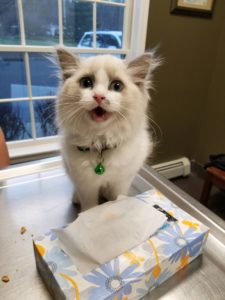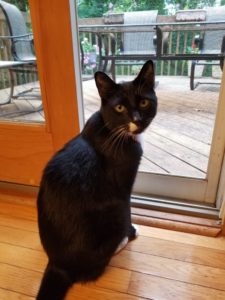 POV: You wake up in the morning and your dog or cat is ready to eat their morning meal. You fill up their bowl with their favorite kibble and place the bowl in front of them. They try to eat the kibble, but you notice that they are only chewing on one side of their mouth and are eating very slowly. They do not finish the food in the bowl. Now while this does not seem like an emergency, your dog or cat may start to lose weight over time due to not being able to finish their food and more importantly, it can indicate pain. You take your pet to their veterinarian and the veterinarian explains that your pet has dental disease and will need some extractions. Could this have been prevented?
POV: You wake up in the morning and your dog or cat is ready to eat their morning meal. You fill up their bowl with their favorite kibble and place the bowl in front of them. They try to eat the kibble, but you notice that they are only chewing on one side of their mouth and are eating very slowly. They do not finish the food in the bowl. Now while this does not seem like an emergency, your dog or cat may start to lose weight over time due to not being able to finish their food and more importantly, it can indicate pain. You take your pet to their veterinarian and the veterinarian explains that your pet has dental disease and will need some extractions. Could this have been prevented?
February is National Pet Dental Health Month! Your pet’s dental health is extremely important for their overall health and quality of life. There are many causes of dental issues for cats and dogs, but the most common is periodontal disease. The problem starts with plaque that eventually hardens into tartar on your pet’s teeth. When plaque and tartar are below the gumline, it sets the stage for inflammation and infection, which can damage the tissue that connects the teeth to the jawbone. Periodontal disease does not stop at your pet’s mouth, it has also been linked to heart and liver disease.
Do not fear, there are many steps you can take as a pet owner to prevent your pet from having a painful mouth.
Signs of Dental Disease
- Bad breath
- Pawing at the mouth
- Chewing on one side of the mouth
- Decreased appetite
- Change in eating habits
- Excessive drooling
- Resistance to having face or mouth touched
Prevention
- Brush. Your. Pet’s. Teeth… Daily. While it is nice that your groomer may brush your pet’s teeth, you may only take your pet to the groomer once every 6-8 weeks (if that). It is ideal to brush your pet’s teeth with veterinary paste (NOT human toothpaste) once a day to prevent plaque build-up.
- Dental chews are a fun way to reward your pet while keeping their dental health in mind. Chews exercise the mouth and act as an abrasive on the teeth. Make sure the chews are not too hard for your pet because then you risk your pet breaking a tooth.
- Water additives are a convenient way to maintain pet dental health and freshen your pet’s breath. These products work by enzymatically breaking down plaque before it can solidify on the teeth. These additives can be flavored or plain.
- Dental Powders
The best products are those recommended by the Veterinary Oral Health Council (VOHC). These products have the VOHC seal on their packaging.
Training for Toothbrushing
Many pets may run away when you chase them around the house with toothpaste on a toothbrush. Would you let someone else brush your teeth that was not highly trained at avoiding the ouch spots? To avoid this, training is necessary, and it is best to use just your finger when brushing your pets’ teeth. Start by using a command and rub your finger along your pets gumline and teeth. After this, reward your pet with a treat they love. Once they are used to this action, try adding the toothpaste on your finger and let your pet smell and taste the toothpaste, then rub it along their gums and teeth as you did before and make sure to reward them after. Keep your pet’s toothpaste right next to where you keep your treats so that your pet associates the toothbrushing with a reward!
Treatment
If your pet has dental disease, it is probably time for a professional cleaning by your veterinarian. First, your veterinarian will obtain a history and perform a full exam including an awake oral examination. Your pet with have pre-anesthetic testing performed, including bloodwork and an electrocardiogram if indicated, prior to being placed under anesthesia. After this is complete, your pet will be placed under general anesthesia and monitored by a licensed veterinary technician. The veterinarian will then perform a sedated oral exam and full dental x-rays will be taken. The teeth are then polished and cleaned, and if needed, surgical extractions will be performed on diseased teeth. After the procedure has ended, your pet is monitored closely while recovering from anesthesia. We take great care to manage anxiety and pain both pre and post dental procedures.
One Final Note…
Professional cleaning is important, but it does not last forever. Within days of getting a professional cleaning, bacteria will begin to lay down plaque in your pet’s mouth once again. Home dental care performed by tooth brushing with a veterinary paste is needed to keep your pet’s dental health in check, even after a professional cleaning.
Product Links
Toothpaste:
Dental Chews:
Oravet Chews –https://jockeyhollowvetpractice.securevetsource.com/itemView/view/51687_HomeDelivery.pml?productId=118576&auto=true
Yummy Combs- https://jockeyhollowvetpractice.securevetsource.com/itemView/view/51687_HomeDelivery.pml?productId=161084&auto=true

 We are sure that you have heard about the mysterious canine respiratory disease that is sweeping the nation and you probably want some answers. The cause of this infectious canine respiratory disease is still under investigation. The most common respiratory diagnostic tests have been largely negative for the known organisms that cause coughing in dogs.
We are sure that you have heard about the mysterious canine respiratory disease that is sweeping the nation and you probably want some answers. The cause of this infectious canine respiratory disease is still under investigation. The most common respiratory diagnostic tests have been largely negative for the known organisms that cause coughing in dogs. 
 September is a crazy month. While trying to get school supplies for your young student and starting to bring out the fun fall décor, we tend to forget about what our pets may need for the upcoming months.
September is a crazy month. While trying to get school supplies for your young student and starting to bring out the fun fall décor, we tend to forget about what our pets may need for the upcoming months.  Congratulations, adopting a pet is so exciting! You are providing an animal with a home while freeing up more space at these rescues and shelters for other animals in need. Although many rescues and shelters try their best to keep these pets happy and healthy, there are always situations where these animals may be sick due to hereditary or congenital conditions or not socialized well due to past experiences/trauma. Even when you purchase a pet, this can still occur.
Congratulations, adopting a pet is so exciting! You are providing an animal with a home while freeing up more space at these rescues and shelters for other animals in need. Although many rescues and shelters try their best to keep these pets happy and healthy, there are always situations where these animals may be sick due to hereditary or congenital conditions or not socialized well due to past experiences/trauma. Even when you purchase a pet, this can still occur.  uly: Fireworks, Traveling, Vet Visits, Yikes!
uly: Fireworks, Traveling, Vet Visits, Yikes! Being the owner of an indoor-only cat has its advantages. As an indoor-cat owner, you do not need to worry about your pet contracting diseases from other fury friends that they may meet during their time outside. You may ask “if my cat lives indoors, why would I need to give him or her a rabies vaccination?” There are a few reasons why a rabies vaccination is so important, even for your indoor-only companion.
Being the owner of an indoor-only cat has its advantages. As an indoor-cat owner, you do not need to worry about your pet contracting diseases from other fury friends that they may meet during their time outside. You may ask “if my cat lives indoors, why would I need to give him or her a rabies vaccination?” There are a few reasons why a rabies vaccination is so important, even for your indoor-only companion.
Recent Comments